商务英语翻译(unit 1 business cards)
- 格式:ppt
- 大小:2.10 MB
- 文档页数:37
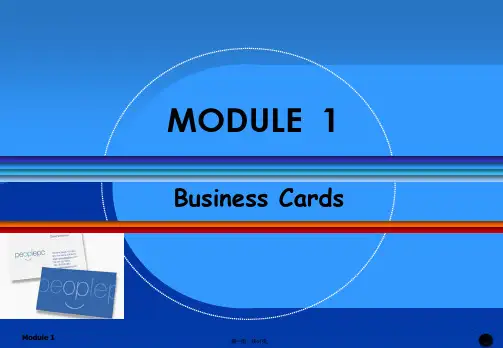
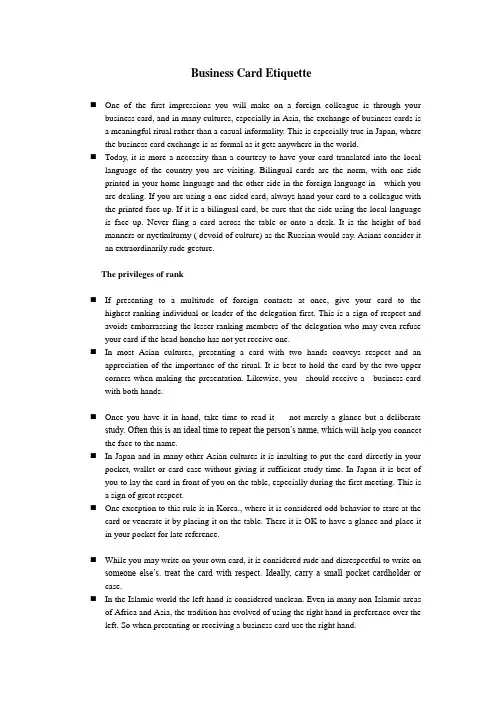
Business Card Etiquette⏹One of the first impressions you will make on a foreign colleague is through yourbusiness card, and in many cultures, especially in Asia, the exchange of business cards isa meaningful ritual rather than a casual informality. This is especially true in Japan, wherethe business card exchange is as formal as it gets anywhere in the world.⏹Today, it is more a necessity than a courtesy to have your card translated into the locallanguage of the country you are visiting. Bilingual cards are the norm, with one side printed in your home language and the other side in the foreign language in which you are dealing. If you are using a one-sided card, always hand your card to a colleague with the printed face up. If it is a bilingual card, be sure that the side using the local language is face up. Never fling a card across the table or onto a desk. It is the height of bad manners or nyetkulturny ( devoid of culture) as the Russian would say. Asians consider it an extraordinarily rude gesture.The privileges of rank⏹If presenting to a multitude of foreign contacts at once, give your card to thehighest-ranking individual or leader of the delegation first. This is a sign of respect and avoids embarrassing the lesser-ranking members of the delegation who may even refuse your card if the head honcho has not yet receive one.⏹In most Asian cultures, presenting a card with two hands conveys respect and anappreciation of the importance of the ritual. It is best to hold the card by the two upper corners when making the presentation. Likewise, you should receive a business card with both hands.⏹Once you have it in hand, take time to read it---- not merely a glance but a deliberatestudy. Often this is an ideal time to repeat the person’s name, whic h will help you connect the face to the name.⏹In Japan and in many other Asian cultures it is insulting to put the card directly in yourpocket, wallet or card case without giving it sufficient study time. In Japan it is best of you to lay the card in front of you on the table, especially during the first meeting. This isa sign of great respect.⏹One exception to this rule is in Korea., where it is considered odd behavior to stare at thecard or venerate it by placing it on the table. There it is OK to have a glance and place it in your pocket for late reference.⏹While you may write on your own card, it is considered rude and disrespectful to write onsomeone else’s. treat the card with respect. Ideally, carry a small pocket cardholder or case.⏹In the Islamic world the left hand is considered unclean. Even in many non-Islamic areasof Africa and Asia, the tradition has evolved of using the right hand in preference over the left. So when presenting or receiving a business card use the right hand.⏹In Europe and North America, business cards are far less formalized and are used merelyto keep track of who’s who during a hectic meeting schedule. If you come to sell in these societies, your hosts will be concentrating on your product not your business card.The Rules of the Card Game⏹It’s not only polite to have your card translated into the local language it is nowconsidered a must. Make it work for you.⏹Always present your card with the printed side up or, in the case of bilingual cards, withthe local language side showing.⏹Wait to be introduced before presenting your business card.⏹Present the cards one at a time in the order of the hierarchy of the delegation.⏹Content: include your name and business title. In some cultures it is common to includeyour academic degrees as well.⏹Business titles can be confusing and often do not translate exactly. If your title is one thatis not internationally common, such as Chief Learning Officer, consider using a translation that avoids the literal and rather portrays your status and job in words or concepts that may be more familiar to your host. Don’t inflate job titles. Also make sure to check the translation. You don’t want Vice President of Sales to come out as President of Vice Selling.⏹Well-known or trademarked acronyms ( such as IBM) need not be translated nor dowords included in logos.⏹Take plenty of cards. It can be highly embarrassing to run out of them and in somecultures it would be an insult.⏹Many executives carry two sets of cards. One set is used purely for introductions and hasno direct contact information. The other is used for more serious encounters and includes detailed contact information.⏹Always treat your colleagues’ cards with respect.New Words⏹ritual 礼节⏹multitude n.多数⏹honcho n.<美俚>上司, 老板⏹venerate v.崇敬。

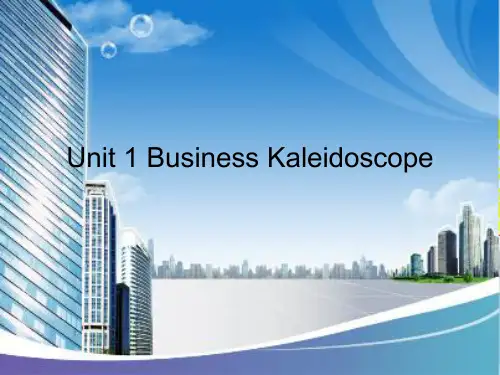
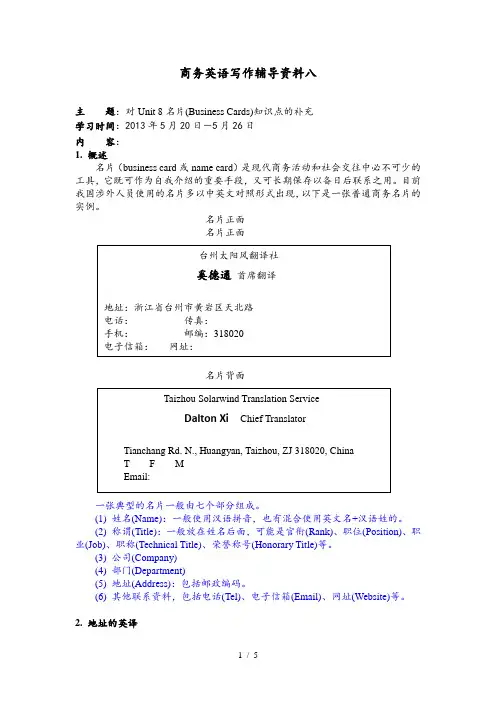
商务英语写作辅导资料八主题:对Unit 8名片(Business Cards)知识点的补充学习时间:2013年5月20日-5月26日内容:1. 概述名片(business card或name card)是现代商务活动和社会交往中必不可少的工具,它既可作为自我介绍的重要手段,又可长期保存以备日后联系之用。
目前我国涉外人员使用的名片多以中英文对照形式出现,以下是一张普通商务名片的实例。
名片正面名片正面名片背面一张典型的名片一般由七个部分组成。
(1) 姓名(Name):一般使用汉语拼音,也有混合使用英文名+汉语姓的。
(2) 称谓(Title):一般放在姓名后面,可能是官衔(Rank)、职位(Position)、职业(Job)、职称(Technical Title)、荣誉称号(Honorary Title)等。
(3) 公司(Company)(4) 部门(Department)(5) 地址(Address):包括邮政编码。
(6) 其他联系资料,包括电话(Tel)、电子信箱(Email)、网址(Website)等。
2. 地址的英译名片的主要功能是联系,所以要在名片上写详细的家庭或单位通讯地址,这是必不可少的一项内容。
例如:住址:浙江省台州市黄岩区天长路18号201室翻译成英文是Address: Room 201, 18 Tianchang Road, Huangyan District, Taizhou City, Zhejiang Province对于上例,翻译时有几点需要注意:(1) 中文地址的排列顺序由大到小,即国、省、市、区、路、号;英文地址则刚好相反,是由小到大的,即号、路、区、市、省、国。
(2) 地名部分应使用汉语拼音,且需连写,如Huangyan不宜写成Huang Yan。
(3) 各地址单元间要加逗号隔开。
行政区的一些常见英译:(1) 国家(State):中华人民共和国(the People’s Republic of China; P. R. China; P. R. C.)。
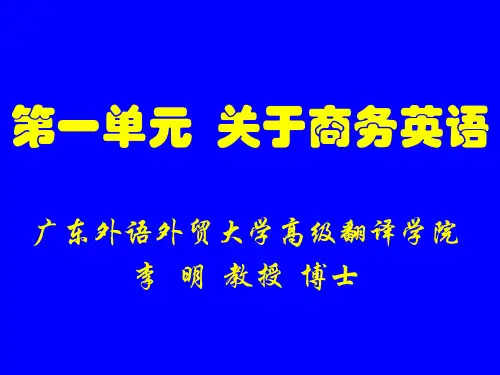
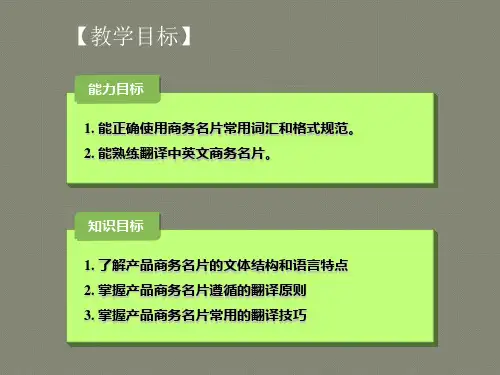
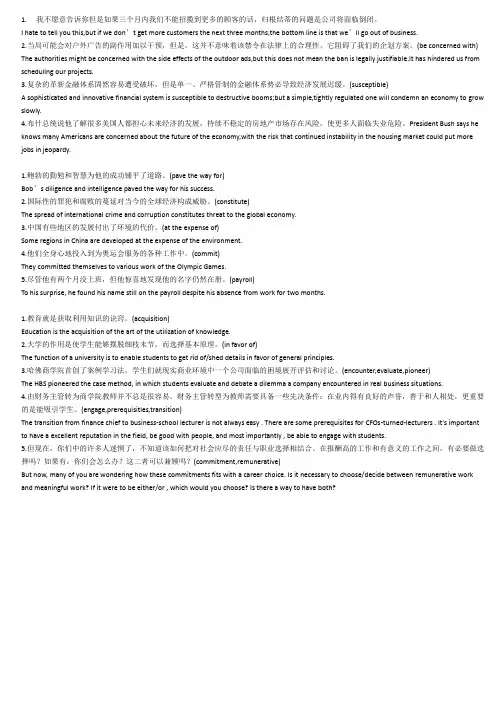
1.我不愿意告诉你但是如果三个月内我们不能招揽到更多的顾客的话,归根结蒂的问题是公司将面临倒闭。
I hate to tell you this,but if we don’t get more customers the next three months,the bottom line is that we’ll go out of business.2.当局可能会对户外广告的副作用加以干预,但是,这并不意味着该禁令在法律上的合理性。
它阻碍了我们的企划方案。
(be concerned with) The authorities might be concerned with the side effects of the outdoor ads,but this does not mean the ban is legally justifiable.It has hindered us from scheduling our projects.3.复杂的革新金融体系固然容易遭受破坏,但是单一、严格管制的金融体系势必导致经济发展迟缓。
(susceptible)A sophisticated and innovative financial system is susceptible to destructive booms;but a simple,tightly regulated one will condemn an economy to grow slowly.4.布什总统说他了解很多美国人都担心未来经济的发展,持续不稳定的房地产市场存在风险,使更多人面临失业危险。
President Bush says he knows many Americans are concerned about the future of the economy,with the risk that continued instability in the housing market could put more jobs in jeopardy.1.鲍勃的勤勉和智慧为他的成功铺平了道路。
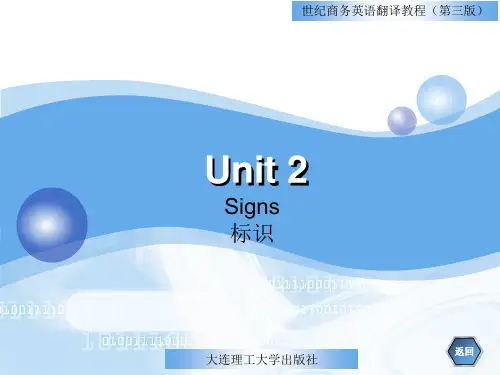
![商务英语翻译实训chapter 1 Translation of Business Cards[精]](https://uimg.taocdn.com/718723e333d4b14e85246844.webp)

商务英语写作辅导资料八主题:对Unit 8名片(Business Cards)知识点的补充学习时间:2013年5月20日-5月26日内容:1. 概述名片(business card或name card)是现代商务活动和社会交往中必不可少的工具,它既可作为自我介绍的重要手段,又可长期保存以备日后联系之用。
目前我国涉外人员使用的名片多以中英文对照形式出现,以下是一张普通商务名片的实例。
名片正面名片正面名片背面一张典型的名片一般由七个部分组成。
(1) 姓名(Name):一般使用汉语拼音,也有混合使用英文名+汉语姓的。
(2) 称谓(Title):一般放在姓名后面,可能是官衔(Rank)、职位(Position)、职业(Job)、职称(Technical Title)、荣誉称号(Honorary Title)等。
(3) 公司(Company)(4) 部门(Department)(5) 地址(Address):包括邮政编码。
(6) 其他联系资料,包括电话(Tel)、电子信箱(Email)、网址(Website)等。
2. 地址的英译名片的主要功能是联系,所以要在名片上写详细的家庭或单位通讯地址,这是必不可少的一项内容。
例如:住址:浙江省台州市黄岩区天长路18号201室翻译成英文是Address: Room 201, 18 Tianchang Road, Huangyan District, Taizhou City, Zhejiang Province对于上例,翻译时有几点需要注意:(1) 中文地址的排列顺序由大到小,即国、省、市、区、路、号;英文地址则刚好相反,是由小到大的,即号、路、区、市、省、国。
(2) 地名部分应使用汉语拼音,且需连写,如Huangyan不宜写成Huang Yan。
(3) 各地址单元间要加逗号隔开。
行政区的一些常见英译:(1) 国家(State):中华人民共和国(the People’s Republic of China; P. R. China; P. R. C.)。